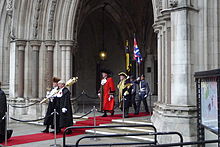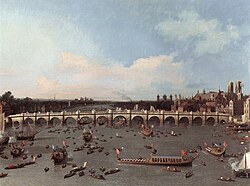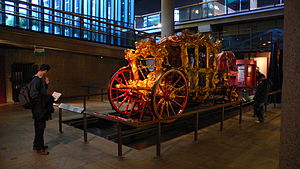Lord Mayor's Show

The Lord Mayor's Show is one of the best-known annual events in London as well as one of the longest-established, dating back to the 16th century.[1] A new lord mayor is appointed every year, and the public parade that takes place as his or her inauguration ceremony reflects that this was once one of the most prominent offices in England.
The 'Lord Mayor' after whom the show is named is the Lord Mayor of the City of London, a city and ceremonial county within Greater London and the historic centre of the wider metropolis, distinct from the position of Mayor of London (a role which has existed only since 2000), namely the elected head of the Greater London Authority, currently Sadiq Khan. The City is London's main financial district, widely known informally as 'the Square Mile'.
The Lord Mayor's Show is centred on a street parade, which in its modern form is a light-hearted combination of traditional British pageantry and elements of carnival. On the day after being sworn in, the Lord Mayor and several others participate in a procession from Guildhall, via Mansion House and St Paul's Cathedral, in the heart of the City of London, to the Royal Courts of Justice on the edge of the City of Westminster, where the new Lord Mayor swears allegiance to the Crown. Until 1882, the procession went to Westminster Hall.[2]
Origin and date of the show[]

The office of Lord Mayor dates from 1189, and it was a requirement of the charter establishing it that the mayor travelled to the royal enclave at Westminster to present himself to the monarch's representatives, the senior judges as Barons of the Exchequer, to take an oath of loyalty to the Sovereign upon beginning his term. The event is officially listed in the City's Civic Calendar as 'The Procession to the Royal Courts of Justice and Presentation of the Lord Mayor to the Chief Justices'; when the Royal Courts moved from Westminster to the Strand location in 1882, the route was shortened. Originally, this journey was mostly made by barge on the River Thames, the usual method of transport for this route in those days. Pageantry and display gradually grew around the trip, comparable to the far less frequent Royal Entry parades that usually followed a coronation or royal wedding. By the 16th century the "show" was firmly established as a major entertainment for Londoners. [3]
In London, the show occurred annually on 29 October.[4] In 1751, Great Britain replaced the Julian calendar with the Gregorian calendar; the Lord Mayor's Show was then moved to 9 November. In 1959, another change was made: the Lord Mayor's Show is now held on the second Saturday in November. The Lord Mayor's Show has regularly been held on the scheduled day; it has not been moved since 1852, when the show made way for Arthur Wellesley, 1st Duke of Wellington's funeral. The show was not interrupted by the Second World War. In 2020 the Show was cancelled because of the COVID-19 pandemic.[5] The Lord Mayor has been making that journey every year for 477 years, surviving plague and fire and countless wars and insurrections. The modern Lord Mayor's procession is a direct descendant of that first journey to Westminster.
The Lord Mayor's transport and the origin of parade floats[]

Formerly, the route was varied each year so that the procession could pass through the Lord Mayor's home ward; since 1952, however, the route has been fixed. The Lord Mayor rode on horseback or went on a barge via the River Thames, based on the route chosen. The river transport for the Lord Mayor's Show gave rise to the word "float" when used in the context of parades.
On more than one occasion, floats have been used as puns on the Lord Mayor's name; in 1616 John Leman had a lemon tree in the procession, while the following year William Cockayne had an artificial cock crowing and flapping its wings. More recently, Sir Murray Fox in 1974 had a large model of a fox in the procession.[2]
Lord Mayor Gilbert Heathcote was unseated from his horse by a drunken flower girl in 1710, breaking his leg. A stand-in coach was used for some years until 1856, the last occasion on which barges were used.[citation needed] In 1757 Sir Charles Asgill, a banker who became the next Lord Mayor, commissioned Joseph Berry of Leather Lane in Holborn to make the Lord Mayor's State Coach which is still used today.[citation needed] The original cost of £1,065.0s.3d. equates to around £120,000, but the replacement value has been estimated at £2 million.[6]
The side panels of the Lord Mayor's State Coach were painted by Cipriani, who also painted those for the monarch's Gold State Coach. It is pulled by six horses, two fewer than the monarch's. The escort to the Lord Mayor's coach recalls the waterborne transport of the Lord Mayor. They are liveried watermen carrying oars: formerly, the Mayor's barge was rowed by members of the Company of Watermen and Lightermen. Riding postillion on the Lord Mayor's State Carriage are two winners of the annual Doggett's Coat and Badge rowing race.
Participants in the show[]
Great Twelve Livery Companies[]
The Great Twelve City Livery Companies — the Mercers, Grocers, Drapers, Fishmongers, Goldsmiths, Merchant Taylors*, Skinners*, Haberdashers, Salters, Ironmongers, Vintners and Clothworkers — participate as of right and the other livery companies by invitation, though the Lord Mayor's "mother company" is always included: in 2019 the Haberdashers' Company.
Privileged regiments of the City of London and others[]

Other participants include bands and members of "privileged regiments" of the City of London such as the Honourable Artillery Company and The Royal Fusiliers. Privileged regiments have the right to march through the City with bayonets fixed, colours flying, and drums beating.
The many other participants lend a unique flavour to the occasion which include organisations that the Lord Mayor wishes to support or has belonged to, such as charities, old schools and business associations before becoming Lord Mayor. St John Ambulance participates, for instance, as do the Zurich Guilds.
Gog and Magog are two woven willow giant reproductions of a pair of statues in the Guildhall. These popular icons reflect the pre-Roman legendary past of the City of London and they too are paraded by volunteers from The each year. The most recent representations were created by members of the Worshipful Company of Basketmakers.
Schedule[]
The procession begins at the Guildhall where the Lord Mayor receives with the new Sheriffs personal gifts from a restricted group of relevant City institutions, usually including the Lord Mayor's own Livery Company and Ward Club and then there is a breakfast. The Lord Mayor is escorted to his or her coach in Guildhall Yard by the Court of Aldermen and sets off to Mansion House, the official residence of the Lord Mayor. There the Lord Mayor awaits the show to pass from the terrace. The Lord Mayor joins the rear of the show, after having watched a flypast by the Royal Air Force.

The route of the outward parade in 2013 was from Guildhall, along Princes Street to Bank junction and past Mansion House. From there the procession travelled down Poultry, Cheapside, New Change, St Paul's Churchyard, Ludgate Hill, Fleet Street and the Strand.
Along the route, the Lord Mayor stops at St Paul's Cathedral in order to receive a blessing from the Dean on the Cathedral steps. Upon arrival at the Royal Courts of Justice on the Strand, the Lord Mayor takes the oath of allegiance. The return procession then reassembles on Aldwych and returns via Essex Street to Temple Place then along the Victoria Embankment and Queen Victoria Street back to Mansion House where the Lord Mayor takes review of the Pikemen and Musketeers of the Honorable Artillery Company. He or she then re-enters Mansion House via the steps to the Terrace with the Aldermen and entertains guests and volunteers who have co-ordinated the event.
The parade, which typically begins at about 11 am, concludes at about 3:30 pm. The procession is over 3 miles (roughly 5 km) long but the route itself is much shorter; the head of the procession reaches the end of the route before the Lord Mayor even leaves Mansion House. In the evening, a fireworks display is held subject to weather conditions.
Televising[]
The Lord Mayor's Show is televised live by the BBC in a special programme typically broadcast on BBC One.[7][8]
Notes[]
- ^ Wickham, Early English Stages ii, pt 1, p.46
- ^ Jump up to: a b Weinreb, Ben and Hibbert, Christopher (1992). The London Encyclopaedia (reprint ed.). Macmillan. p. 498.CS1 maint: uses authors parameter (link)
- ^ Show website, "History"
- ^ Hutton 1994, p. 187-188.
- ^ City of London, Press Release, 21 September 2020
- ^ Lord Mayor's Show website, "The State Coach" Accessed 5 December 2013.
- ^ BBC iPlayer Lord Mayor's Show (2010)
- ^ "Thousands watch Lord Mayor's Show". 12 November 2011. Retrieved 14 August 2018 – via www.bbc.co.uk.
References[]
- Hutton, Ronald: The Rise and Fall of Merry England: The Ritual Year 1400–1700, Oxford University Press, 1994, ISBN 0-19-285447-X
- Bidmead, Julye: The Akitu Festival, Gorgias Press, 2002, ISBN 1-931956-34-0
External links[]
- Official site
- BBC News Crowds gather for Lord Mayor's Show in London 13 Nov 2010
| Wikimedia Commons has media related to Lord Mayor's Show. |
Coordinates: 51°30′55.97″N 0°5′32.18″W / 51.5155472°N 0.0922722°W
- Festivals in the City of London
- Annual events in London
- Parades in London
- November observances
- Autumn events in England
